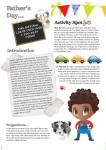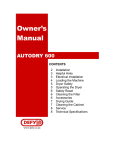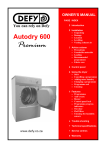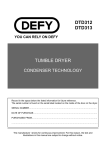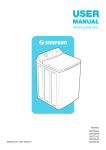Download Defy 5KG AUTODRYER Owner`s manual
Transcript
Owner’s Manual AUTODRY CONTENTS 2 2 3 4 4 5 5 6 7 7 8 8 8 Introduction Installation The Control Panel Loading Step by step operating procedure Drying Time Drying Guide Fabric Hints Unsuitable Materials Maintenance Owner’s Responsibility Trouble Shooting Specifications www.defy.co.za 1 INTRODUCTION You are now the proud owner of one of the finest and most modern tumble dryers that today’s technology can produce. You and your Autodry are going to make a great team together. But first it will pay if you really get to know each other. This book will tell you all you need to know about your machine, what it will do and how to do it. Please read all the instructions carefully before operating the machine. INSTALLATION Floor Standing • Remove all packaging. • The tumble dryer should be placed in a well-ventilated area. If the Dryer is operated in a confined space, moisture extracted from the clothing during the drying process will condense on the walls. • The rear of the Dryer must be free of any restrictions, especially round the fresh air grille. Do not position the Dryer near any long curtains or drapes as these could be drawn against the air intake grille. This would result in a much longer drying time. • Allow a 100 mm. Air gap at the rear of the Dryer for ventilation purposes. The appliance must be earthed and the manufacturer and seller do not accept responsibility for any damage due to incorrect electrical connection. Electrical • The dryer is designed to operate on a 230 volt, 50 Hz, 15 Amp, AC power supply. • The power cord has a 15 Amp moulded plug attached. • This plug should be pushed into a 15 Amp earthed wall. • If the power cord should ever need replacing, use only a genuine cord available from the nearest Defy Service Centre. 2 THE CONTROL PANEL 1 2 1. 2. 3. 4. 5. 3 Drying guide Hot / Warm selection button Power ON / OFF button Timer knob Indicator light 4 5 Turn timer knob Clockwise only 1. Drying guide • The guide is indicative of the types of fabric that should be dried on the HOT (normal) or Warm (delicate) drying cycles. 2. Hot / Warm selection button • This button knob allows the selection of High (HOT) or Low (WARM) drying cycles. • We recommend that a hot cycle be used for normal wash loads and a warm cycle for delicate articles. • If the button is not pressed the machine will operate on a HOT cycle. • If the button is pressed in, the machine will operate on a warm cycle. • There is an automatic 10 minute cooling down period at the end of each drying cycle. 3. Power On / Off button • Pushing the button will start the machine but only if a time cycle has been selected. • Pushing the button again will switch the machine off. 4. Timer knob • Turn the knob clockwise only to select the required drying period. • If the required setting is accidentally bypassed, do not turn the knob back but continue turning clockwise to the desired setting. 5. Indicator light This light indicates that the machine is switched on. The Door • To open the door, pull on the handle. • Opening the door, during the drying cycle, will stop the machine. • Closing the door will allow the machine to complete the drying cycle. 3 LOADING • • • • • • • Do not overload the machine. We recommend loading the drum to the halfway mark. The capacity of the machine is 5kg of spin dried articles. Do not place dripping wet articles in the Dryer. As much water as possible should be extracted from them before placing them in the drum. Clothes should not be loaded in a tangled condition as this will prolong the drying time. When loading, shake out each article and place it in the drum. Mix small and large articles for faster more even drying. It is recommended that synthetic whites and coloured articles are not mixed until their colourfastness has been established. Add a few hand towels to act as buffers when drying a very small load. Blankets and other large items tend to retain a certain position in the drum. To ensure thorough drying it may be necessary to remove these articles midway during the drying cycle and reposition them before continuing. STEP BY STEP OPERATING PROCEDURE 1. 2. 3. 4. 5. Insert the electrical plug into the wall socket. Open the door. Load the clothes into the Dryer as per the previous recommendations. Close the door. (The Dryer will not operate if the door is open.) Select the desired heat setting and drying time using the timer knob. Refer to the drying guide in this book NEVER turn the timer knob to the left. (Anticlockwise) 6. Push the ON / OFF button and the machine will commence with the selected drying cycle. The machine has a reverse tumble action which reduces creasing, tangling, knotting and subsequent ironing. This reverse tumble action also ensures even smooth drying. 7. You may interrupt the cycle to add or remove clothes at any time by simply pushing the ON / OFF button and then opening the door. The machine will restart when the door is closed and the ON/OFF button is pushed once more. 8. At the end of the drying cycle there is a cooling down period of about 10 minutes. This cooling cycle effectively minimises creasing. 9. At the end of the cycle the drum will stop rotating. 10. Push the ON / OFF button. Open the door and remove the dried articles. It is recommended that this be done soon after the machine has stopped to minimise creasing. 11. If you have completed the days drying, switch off at the wall socket and remove the plug to prevent accidental operation. 4 DRYING TIME • • • No accurate drying time can be quoted as this depends on the makeup of the load, the dryness required and the amount of moisture present in the articles when placed in the machine. Avoid over drying. All fabrics hold a certain amount of natural moisture. Over drying can result in “hard” clothes, shrinkage and set creases. Clothes removed from the Dryer when feeling slightly damp, will feel dry when cooled DRYING GUIDE The following table is intended as a guide only. Personal experience will soon tell what times are required for typical loads. normal load be placed in the drum when drying these garments. Fabric Size of load Heat selection Time in minutes Cotton, Linen and Toweling Full Hot 120 – 150 Synthetics and Delicates Full Warm 30 – 40 *Permanent press Half Hot 120 – 150 **Wool Full Warm 35 - 95 • *Permanent press garments should be removed immediately after the drying cycle is completed and put on a hanger to avoid creases. It is recommended that half the normal load be placed in the drum when drying these garments. • **The drying of woolen garments is not recommended as shrinkage and distortion may occur. 5 FABRIC HINTS Always check garment care labels for the manufacturer’s recommendation Blankets • Extract most of the water from the blanket before drying. • Place 2 to 3 towels in the Dryer and allow the Dryer to pre heat for 10 minutes on a HOT setting. • Switch to the WARM setting before placing the blanket in the Dryer. • Remove the blanket while it is still slightly damp. • Reshape and hang out to dry. • When dry, brush to raise the nap and press the binding with a warm iron. Cotton T-shirts and Knit underwear • Dry only to a slightly damp stage. If these articles are allowed to tumble too long, the knitted cotton may shrink. This may be corrected by re dampening or by wearing the article. Curtains and slip covers • Remove from the Dryer while slightly damp. • Iron and hang immediately. Chenille and candlewick Bedspreads • Dry only one bedspread at a time. • Remove as much moisture as possible before placing the bedspread in the Dryer. • Dry completely. Lingerie • Use the WARM setting. • Remove soon after drying to minimize creasing. • To avoid tangling, it is recommended that Nylon stockings are enclosed in a Nylon mesh bag during drying. Knitted synthetics • Use the WARM setting. • Use a dry towel as a buffer. • As rubbing surfaces may cause small beads to form, it is advisable to turn these articles inside out. Corduroy • Turn inside out. • Remove while still damp and reshape. Silks, Dacrons and nylons • Place in the Dryer separately • Do not over-dry 6 UNSUITABLE MATERIALS The following items must NOT be placed in the Dryer as they pose a fire risk. • Chemically impregnated fabrics such as mops or cleaning cloths saturated with wax or inflammable solvents. • Rubber backed articles, rubber boots, and tennis shoes. • Clothes fitted with foam rubber pads. • Garments treated with dry cleaning fluid or a combustible solution. • Durable pleated items other than permanent press. • Fibre-glass or leather items. MAINTENANCE Cleaning the Lint Filter • The micromesh lint filter assembly is located at the front of the door. FILTER HOUSING • The mesh should be cleaned after each load to maintain optimum drying LOCATING SPIGOT efficiency. FILTER MESH • While holding the door closed with one hand, insert two fingers of the other hand, into the large central holes of the filter assembly and pull it free of the HOLD locating spigot. • Gently rub the filter mesh to loosen and remove accumulated lint and fluff. • Locate the assembly in the door surround and push on the central button to clip the filter into place PULL TO REMOVE PUSH TO INSTALL over the locating spigot. Cleaning the rear Air Intake Grille • The air intake grille, at the bottom rear of the machine, should be cleaned regularly to maintain optimum drying performance. • Remove any obstructions and dust the grille off with a soft brush. Cleaning the cabinet • The surfaces of the Dryer need very little attention. • Periodically wipe the inside of the drum and then the outer cabinet with a damp cloth. ON NO ACCOUNT USE BENZENE OR OTHER SOLVENTS TO CLEAN ANY PART OF THE MACHINE. A DAMP CLOTH WILL NORMALLY SUFFICE OR IF DESIRED 7 OWNER’S RESPONSIBILITY Since the following are not factory faults, they are the owner’s responsibility. • Damage to exterior finish. • Breakage of components • Damage through improper use or installation of the appliance. • Damage caused by moving the appliance. TROUBLE SHOOTING If you experience a problem with the machine, please check the following before calling a Service technician. It may seem obvious …..but you may be charged for a service call, even during the warranty period, if no fault is found. 1. 2. Check that the cord is plugged in and that the wall switch is on. Check that there is power to the wall socket by testing the socket with a small electric appliance such as a kettle in the socket. 3. Check if a house fuse has blown or a circuit breaker has tripped out. 4. Check that the laundry is evenly distributed round the drum. 5. Check that the machine is not over loaded. 6. Check that the dryer door is firmly closed. 7. Check that the timer is not set to ‘0’. 8. Check that the ON / OFF button is pushed in. 9. Check that the lint filter has been cleaned. 10. Check that the air intake grille at the rear of the machine has not been obstructed by a foreign object. DO NOT ATTEMPT REPAIRS YOURSELF SPECIFICATIONS Dimensions Height 850 mm Width 600 mm Depth 560 mm Voltage 230V. 50Hz Heater 1 x 1900W Motor 275W Net Weight 35Kg Capacity 5kg of dry material The Manufacturer strives for continuous improvements. For this reason, the text and illustrations in this book are subject to change without notice. Part Number 063 566 8








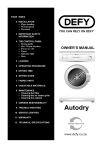

![8KG HEAT PUMP DRYER [Met DTD 315]](http://vs1.manualzilla.com/store/data/005851733_1-4b2b64d3b006b4e2563952fefa7cfd52-150x150.png)
